I am trying to get familiar with LazyVGrid, layout and frames/coordinate spaces in SwiftUI and draw a grid that has 4 columns, each being 1/4 the width of the screen. On top of that, on cell tap, I want to place a view exactly over the tapped cell and animate it to full screen (or a custom frame of my choice).
I have the following code:
struct CellInfo {
let cellId:String
let globalFrame:CGRect
}
struct TestView: View {
var columns = [
GridItem(.flexible(), spacing: 0),
GridItem(.flexible(), spacing: 0),
GridItem(.flexible(), spacing: 0),
GridItem(.flexible(), spacing: 0)
]
let items = (1...100).map { "Cell \($0)" }
@State private var cellInfo:CellInfo?
var body: some View {
GeometryReader { geoProxy in
let cellSide = CGFloat(Int(geoProxy.size.width) / columns.count)
let _ = print("cellSide: \(cellSide). cellSide * columns: \(cellSide*CGFloat(columns.count)), geoProxy.size.width: \(geoProxy.size.width)")
ZStack(alignment: .center) {
ScrollView(.vertical) {
LazyVGrid(columns: columns, alignment: .center, spacing: 0) {
ForEach(items, id: \.self) { id in
CellView(testId: id, cellInfo: $cellInfo)
.background(Color(.green))
.frame(width: cellSide, height: cellSide, alignment: .center)
}
}
}
.clipped()
.background(Color(.systemYellow))
.frame(maxWidth: geoProxy.size.width, maxHeight: geoProxy.size.height)
if cellInfo != nil {
Rectangle()
.background(Color(.white))
.frame(width:cellInfo!.globalFrame.size.width, height: cellInfo!.globalFrame.size.height)
.position(x: cellInfo!.globalFrame.origin.x, y: cellInfo!.globalFrame.origin.y)
}
}
.background(Color(.systemBlue))
.frame(maxWidth: geoProxy.size.width, maxHeight: geoProxy.size.height)
}
.background(Color(.systemRed))
.coordinateSpace(name: "testCSpace")
.statusBar(hidden: true)
}
}
struct CellView: View {
@State var testId:String
@Binding var cellInfo:CellInfo?
var body: some View {
GeometryReader { geoProxy in
ZStack {
Rectangle()
.stroke(Color(.systemRed), lineWidth: 1)
.background(Color(.systemOrange))
.frame(maxWidth: .infinity, maxHeight: .infinity)
.overlay(
Text("cell: \(testId)")
)
.onTapGesture {
let testCSpaceFrame = geoProxy.frame(in: .named("testCSpace"))
let localFrame = geoProxy.frame(in: .local)
let globalFrame = geoProxy.frame(in: .global)
print("local frame: \(localFrame), globalFrame: \(globalFrame), testCSpace: \(testCSpaceFrame)")
let info = CellInfo(cellId: testId, globalFrame: globalFrame)
print("on tap cell info: \(info)")
cellInfo = info
}
}
.frame(maxWidth: .infinity, maxHeight: .infinity)
}
.background(Color(.systemGray))
}
}
The outermost geometry proxy gives this size log:
cellSide: 341.5. cellSide * columns: 1366.0, geoProxy.size.width: 1366.0
This is what gets rendered:
When I tap on cell 1 for example, this is what gets logged:
local frame: (0.0, 0.0, 341.0, 341.0), globalFrame: (0.25, 0.0, 341.0, 341.0), testCSpace: (0.25, 0.0, 341.0, 341.0) on tap cell info: CellInfo(cellId: "Cell 1", globalFrame: (0.25, 0.0, 341.0, 341.0))
When tapping on "Cell 6" this is what the newly rendered screen looks like:
So, given this code:
- how can I get the (white) overlaid view's frame to match the cell's view's frame I tapped on? The width and height seem ok, but the position is off. (What am I doing wrong?)
- How can I get the white view to animate to full screen once placed right on top of the tapped cell?

